1955 Italian Grand Prix race report: Fangio crowned F1 champion for third time
Mercedes claim another crushing win for as their lead driver Juan Manuel Fangio wins the driver's title
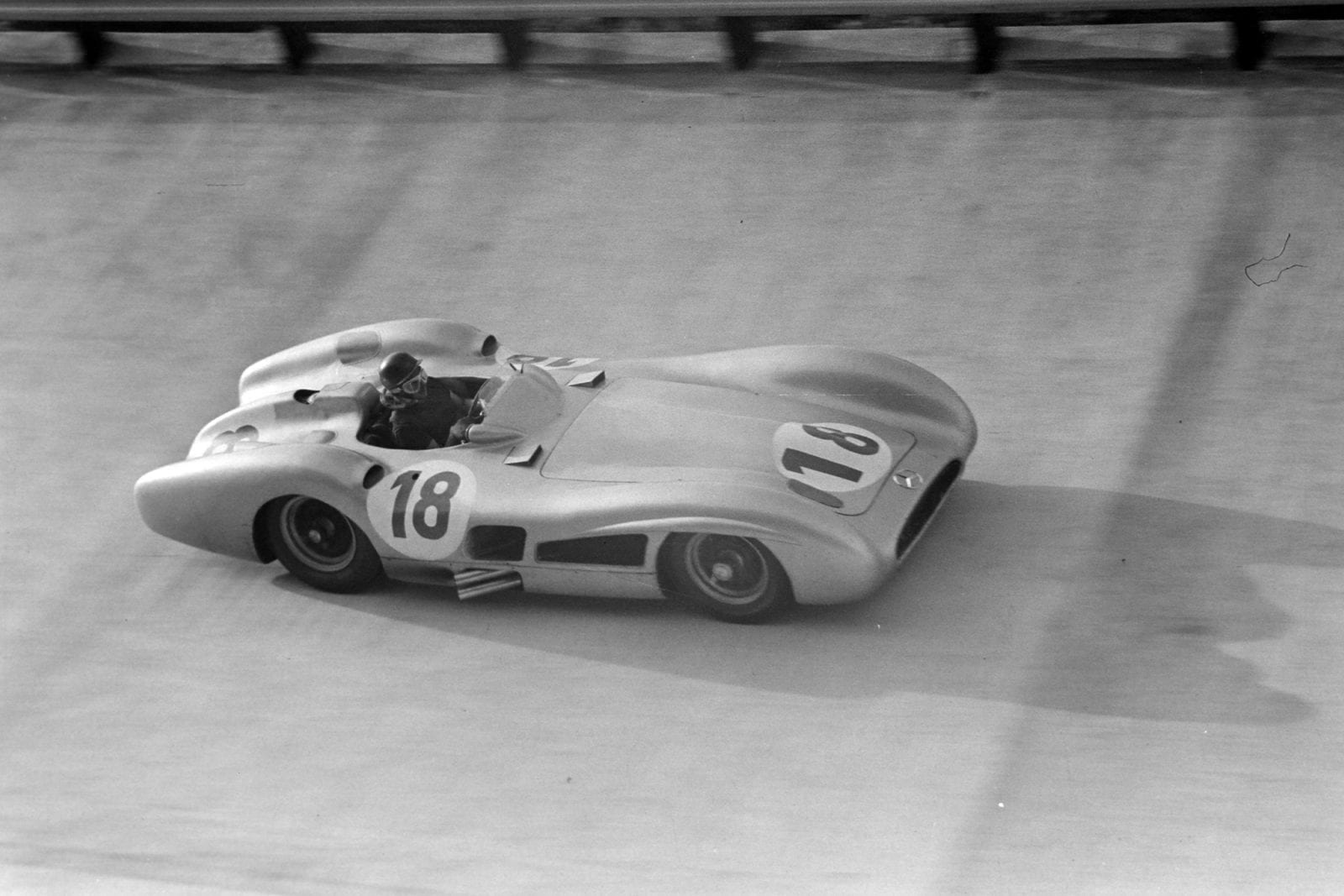
Motorsport Images
After a fantastic amount of hard work the rebuilt Monza Autodrome was completed well before the Grand Prix was due to take place, and most of the leading teams put in some training before official practice started. At the end of the long wide straight past the pits a steeply-banked concrete curve was built on a radius of nearly 350 yards, running over the back leg of the old circuit, then parallel with the two existing straights, round a similar steep concrete banking to rejoin the beginning of the wide finishing straight.
The famous pave turns at Vedano were not used, a new corner being built to join the two straights of the old circuit before the south banking was reached. By dividing the finishing straight into two parts, by means of little white rubber pylons, it was possible to make a full circuit of 10 kilometre length. The start was situated on the outside of the straight in front of the grandstands, running round the road circuit, via the Lesmo corners, down the back straight and round the new south corner, to rejoin the pits straight.
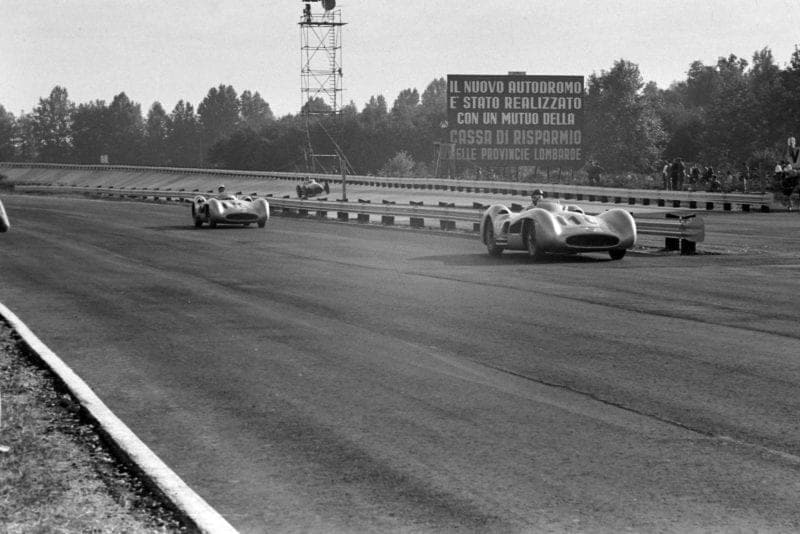
Fangio leads Moss
Motorsport Images
This time the cars passed the grandstands on the inside of the white pylons, went on to the north banking to complete a full lap of the speed circuit, and rejoined the grandstand straight to finish the full lap. By removing the white pylons it was possible to use only the speed circuit of two straights and two bankings. The full circuit provided a view of the cars on three occasions during one lap, but meant that any pit stops would have to be made at the end of a half lap instead of a full one.
In addition to the rebuilt track numerous other improvements were made during the past nine months, such as a foot-tunnel under the finishing straight, extra pits and trade stands, new internal roads to give access to corners, and a pave surface in the paddock, to replace the original sandy gravel. Altogether the Italians had made an enormous effort and improved the already excellent Monza Autodrome beyond all recognition.
With no Grand Prix race since the British race at Aintree, all the leading teams turned out in force and unofficial practice had shown that the new lap speeds would be of the order of 2 min 50 sec or less, with a speed of over 211 kph, while the banked oval could be turned in nearly 1 min for the 4.25 kilometres, giving the impressive speed of over 250 kph (155 mph).
Qualifying
As a wise precaution the regulations restricted the Thursday practice period to the banked circuit only in order that drivers could get accustomed to driving on the bankings, for there is much to learn about high-speed super-elevated curves, as anyone who has driven at Montlhèry, or Brooklands in earlier days, will know. The Mercedes-Benz team were out in full force, but most interest lay in the appearance of the Lancia cars, now running under the Ferrari insignia.
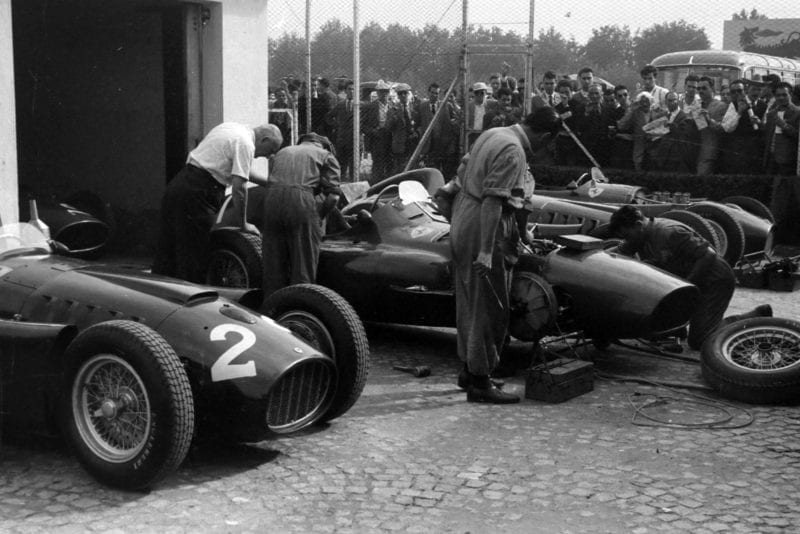
The Ferraris are prepared in the pits
Motorsport Images
There were three cars entered, with Farina, Castellotti and Villoresi as drivers, with a spare training car, and since Ferrari took over the whole racing stable of Lancia the cars have not been altered, appearing the same as earlier in the season. It was noticeable that the original Lancia mechanics were still looking after them, though wearing brown Ferrari overalls, and engineer Jano was in attendance.
In addition to the three Lancia cars entered by Enzo Ferrari there were three Tipo 555 Super Squalo Ferraris, on which a great deal of detail development had been done, including the fitting of five-speed gearboxes. There was a spare car for this trio and they were looked after by the regular Ferrari mechanics, though no longer with Meazza in charge, he having left the Scuderia Ferrari after nearly 26 years’ association and joined the development section of Bugatti. The Super Squalo drivers were Hawthorn, Trintignant and Maglioli.
Mercedes-Benz entered four cars, to be driven by Fangio, Moss, Kling and Taruffi, and brought along a varied collection of different length cars, both streamlined and unstreamlined. There were seven Maseratis entered, but on this first day only one was present and that did not practise, it being an early factory car lent to Gould while his own was being repaired. The only team from England was the Vanwall and Schell and Wharton had the regular cars, with tidier cockpit cowling and fairings over the suspension, while there was a complete spare car to hand should the occasion arise.
Gordini entered two 1954 cars with 1955 engines and disc brakes, driven by Silva Ramos and Pollet, and Manzon was giving the new eight cylinder Gordini its first outing. This new car was very smoothly contoured, with a fairing over the nose and across the front of the wheels, while the eight-cylinder engine was modelled on the existing 1955 six-cylinder, fitted with four double-choke Weber carburetters, a multi-pipe exhaust system terminating in front of the near-side rear wheel. A normal four-speed box was used and the rear end was independent with the disc brakes mounted inboard.
The whole of the afternoon was warm and dry and in consequence the tyre experts were getting worried as speeds round the banked circuit were around 250 kph (155 mph). There was quite a stir when Farina had a rear tread come off and his Lancia spun on the banking, writing off the rear end completely in the process, he being very lucky to escape unhurt. Trintignant also had a tread start to lift and other cars were corning in with their tyres unduly hot.
The Mercedes-Benz team were scratching their heads as their unofficial practice had showed that a fully-streamlined medium length chassis was the best combination, and now the drivers all found that the old original long-chassis car, as used in 1954, was the best for handling on the banking. They only had one such car, with a lower and better contoured fully-streamlined body, so the high-speed transporter was put into service to rush back to Stuttgart and fetch another one, while a third chassis was made and fitted with one of the 1954 bodies.
“The Tipo 555 Ferraris were handling remarkably well on the bumpy concrete bankings but lacked power”
The Tipo 555 Ferraris were handling remarkably well on the bumpy concrete bankings but lacked power, while the Vanwalls and the Gordinis were giving their drivers a rough ride, especially Schell, who was trying hard. Almost all the cars were having their suspensions modified to give more ground clearance as the bumps on the bankings were causing many of them to ground the bottom of the engines or rear axles.
By the end of the afternoon everyone was beginning to wonder about this new high-speed track, the very steep bankings being completely new to many of the drivers, and not a little frightening.
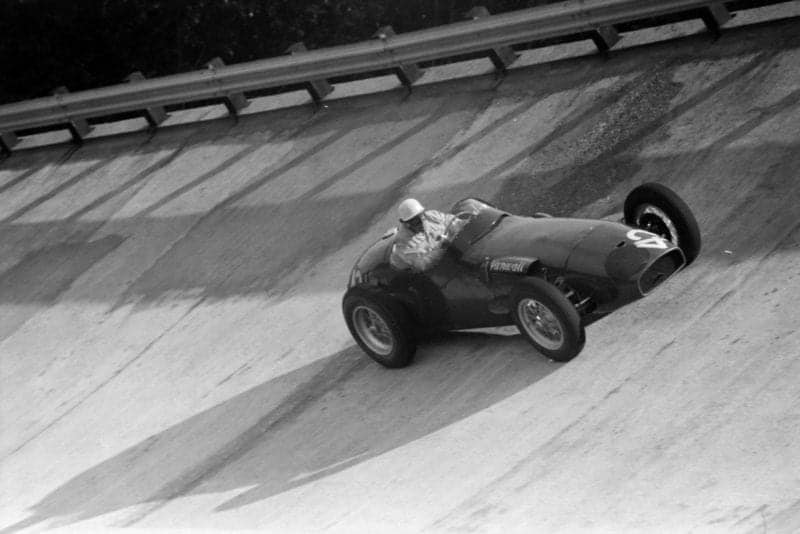
Harry Schell takes to the banking in his Vanwall
For Friday afternoon the full 10-kilometre circuit was put into use and times taken to decide the starting-grid positions. As has become a habit, Fangio and the Mercedes-Benz set the pace, but Castellotti and Farina were in excellent form with the Lancias. Moss was not making any real effort, as he was still waiting for a long-chassis car to arrive from Stuttgart; Kling was really trying and recorded second fastest practice lap.
The Maserati team turned out with Behra driving a very pretty fully-streamlined car on which the wheels were exposed at the top, rather like the old Golden Arrow of Sir Henry Segrave. The chassis was a new one, but similar to the other team cars of Musso, Mieres, Collins and Menditeguy. Peter Collins was having his first try-out in a Grand Prix team, as was Menditeguy the Argentinian driver.
Outwardly the Maseratis were little changed, but closer inspection revealed new front brakes, with wider drums, slightly downdraught carburetters on all except Menditeguy’s car, the two exhaust manifolds running into a single large-diameter tail-pipe, five-speed gearboxes and larger fuel pumps driven by belts from the prop.-shaft, while the bodywork was fitted with larger and smoother-looking Perspex windscreens. The only private owners were Gould and Fitch, the former driving a borrowed factory car and the latter driving the grey Moss Maserati.
In an attempt to improve the handling of the medium-length streamlined car on the banking. Mercedes-Benz built a long nose cowling on one of the cars, this helping to keep the front wheels down. Hawthorn tried the spare Lancia car but did not go fast as he was too big to fit into the cockpit comfortably, it not being possible to stretch the driving position any farther. The new Gordini was driven by Lucas, as Manzon had to return home to attend to family matters, and practice ended with none of the teams in a very happy state.
The fastest six at the end of the first day were Fangio, Kling, Castellotti, Farina, Behra and Moss, with over 4½ seconds between them, a different story from previous Monza races where as many as twelve cars would have only half that difference between them. The new banked circuit was proving very fast and most spectacular, but it was removing the very close racing of the old circuit.
The final practice period was due to be held on Saturday morning, but as it poured with rain all the time the period was extended for the afternoon, by which time the sun had come out and dried a great deal of the track. However, during the torrential rain of the morning Mercedes-Benz did some testing, both Kling and Taruffi putting in many laps, looking more like speedboats than racing cars.
By the middle of the afternoon things began to warm up in true Monza style and there was a great deal of activity, with Mercedes-Benz and Lancia going very fast. Fangio was content with his previous day’s performance and did not practice again, but Moss was out with his new car that had arrived overnight. The medium-length streamlined car that had been fitted with the temporary nose cowling had had yet another type fitted, the aluminium sheet being welded in the workshop lorry and pop-riveted onto the existing body. Though there was no intention to use the car in the race it was doing a great deal of running, giving the technicians some valuable data.
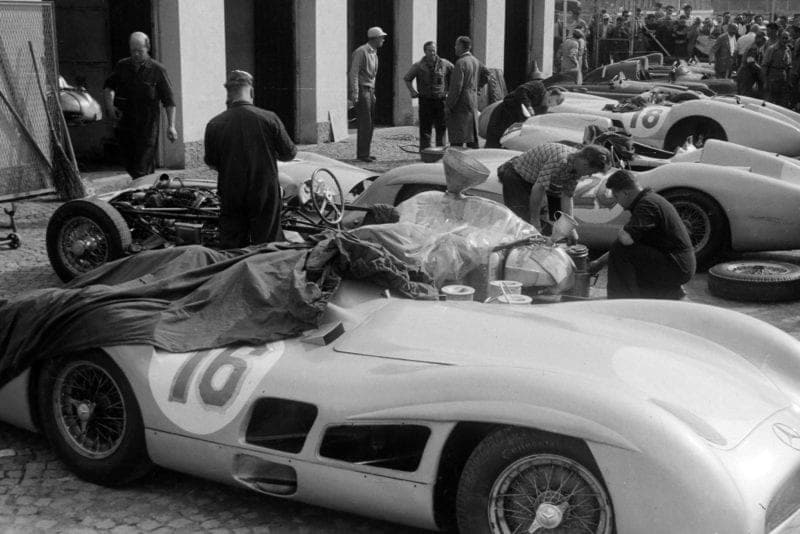
The Mercedes challengers are worked on in the garage
Motorsport Images
The streamlined Maserati did not appear on this day, Behra contenting himself with a few laps in a normal Maserati, while the Vanwalls had been changed from 16-in, wheels to 17-in, in order to try and minimise, the possibility of tyre trouble, the cowlings over the front suspension being removed to give clearance. All the Maseratis were using similar size tyres and Pirelli hoped they would be all right for the whole race. The Continental tyre people were perfectly happy about the tyres on the Mercedes-Benz, even though they were still 16-in, but Englebert were far from happy with their tyres on the Scuderia Ferrari cars, especially on the very fast Lancias driven by Castellotti and Farina.
By the end of the afternoon Moss had made fastest lap of the period, but his usual fraction of a second slower than Fangio’s time, Kling equalled his previous time, which gave him third best of the whole training, and the two fastest Lancias were next, with Behra in the streamlined Maserati a little way behind. Shortly before the end of training Farina saw another tread lifting off one of his tyres, this time on the front, and before any excitement took place he was able to slow up, but justifiably worried nevertheless. Running the race over the combined road and track circuit was setting a big problem to the tyre experts, for the banked oval really demanded track tyres with thin treads, but normal road-racing covers had to be used to cope with the road section.
Fortunately, Sunday proved to be bright and sunny, but not the usual sweltering heat enjoyed by Monza, and tyre troubles did not seem so worrying, but in spite of this the Lancias were withdrawn, as the possibility of a burst tyre was too great to chance, it not being possible to change to another make. As the Scuderia Ferrari had a spare Tipo 555 Castellotti was allowed to drive it. Farina and Villoresi becoming spectators. he start was due to take place at 3pm but due to a wonderful Italian “comic-opera” during which the President of Italy officially opened the reconstructed Autodrome, driving round in a very pretty drophead 2-litre Maserati, it was after 3:30pm before the drivers got in their cars and engines were started. Until then Fangio had been reclining in the shade of Neubauer’s huge shadow, the team chief standing over his number one driver like an enormous hen with her favourite chick.
Race
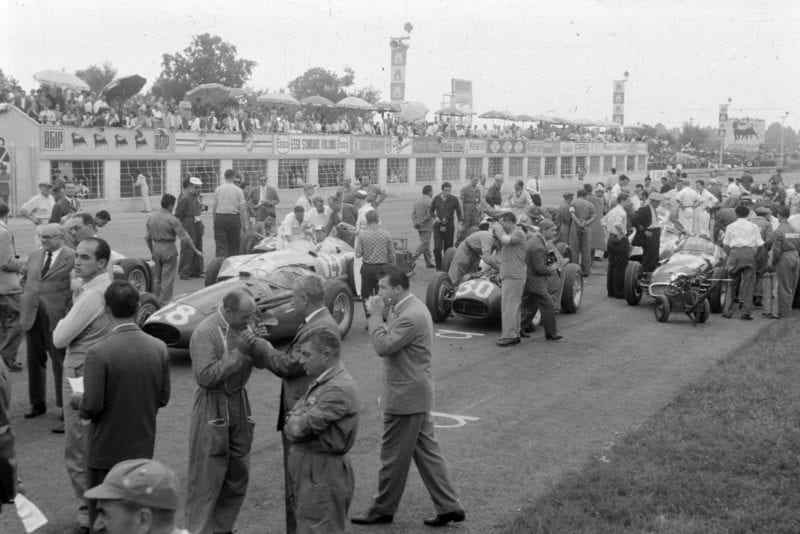
Cars line up on the grid
Motorsport Images
The twenty cars lined up in rows of three-two-three, with Fangio, Moss and Kling in the front, Castellotti in row two on his oven in the Ferrari, in spite of not having practised in the car, and the Maseratis of Behra and Mieres behind, with a space beside them where the missing Villoresi should have been. Once more Schell was the main British hope, having got his Vanwall placed among the red cars. Of the German cars, Fangio had the new long-chassis streamlined car, with inboard brakes, Moss had a similar one with last year’s bodywork, Kling a new unstreamlined long-chassis one with inboard brakes and Taruffi a medium-length one with outboard brakes. Behra was on the streamlined Maserati, while the Ferrari team were more or less identical.
“As the flag fell Moss made one of the best starts of his Grand Prix career and just managed to beat Kling with the lighter car”
Musso went off with the pack and then the car faltered and he was passed on all sides. With the new circuit the start led into the Grande Curve and at the half-lap the field passed the grandstands on the pits side, before taking the North banking, and it was Moss who led comfortably from Fangio, Taruffi, Kling and Castellotti. However, orders are orders if you want to stay in the team, and at the end of the lap Fangio was in his usual position, followed by the rest of his team and Castellotti. Already the rest of the field were falling behind and Wharton had stopped at the pits and retired with a broken injection-pump mounting.
After only two laps the four Mercedes-Benz cars were comfortably in line-ahead formation but Castellotti was doing all he knew to hang on to them, the Italian crowd screaming with joy at this terrific display of tenacity. The few British present were getting joy from watching the effervescent Schell in the thick of a six-car battle with two Ferraris, two Gordinis and a Maserati, the green car giving as good as it was getting.
Castellotti wore himself out after four laps and began to drop back a bit, but was still way out in front of the rest of the runners, while Schell had the Vanwall’s nose in front of Maglioli, Trintignant, Silva Ramos, Pollet and Menditeguy. Although this bunch were striving for 12th place it was as good an exhibition of real motor racing seen for a long time. Mieres and Hawthorn were locked in battle for sixth position but Musso was closing on them, having passed Gould, Behra and then Collins in quick succession.
Lapping at 2 min 53 sec, against the 2 min 46 sec of practice, Fangio led the triumphant Mercedes-Benz procession more and more into the lead, poor Castellotti having no one to back him up in his lone battle. Musso was in great form and got into sixth place by lap seven, while Maglioli began to shake himself free of his little group, Schell dropping out with a broken de Dion tube, the hammering of the bankings being more than it could stand.
Once out on his own Maglioli caught up with Gould and elbowed his way past the Maserati, but the burly Englishman was getting the hang of Grand Prix tactics and soon elbowed his way back again, eventually teasing Maglioli into making a mistake, which dropped hint a long way back. Collins had been running steadily in the middle of the field but had to make a brief call at the pits to have some bits screwed back on and this put him right out of the picture, while Trintignant suffered the same fate.
Lap after lap the German procession continued, Moss always in Fangio’s shadow with Kling and Taruffi a little way behind, there being only 4 sec between the first and the fourth. Half-way round the 17th lap Musso closed on Castellotti and these two started a very close battle which was to go on for a long time, the two red cars being only inches apart at times. Behra’s streamlined Maserati was not proving as fast as expected and was behind Mieres’ normal type of Maserati, though the Argentinian eventually dropped right back when he stopped to have a look at his engine.
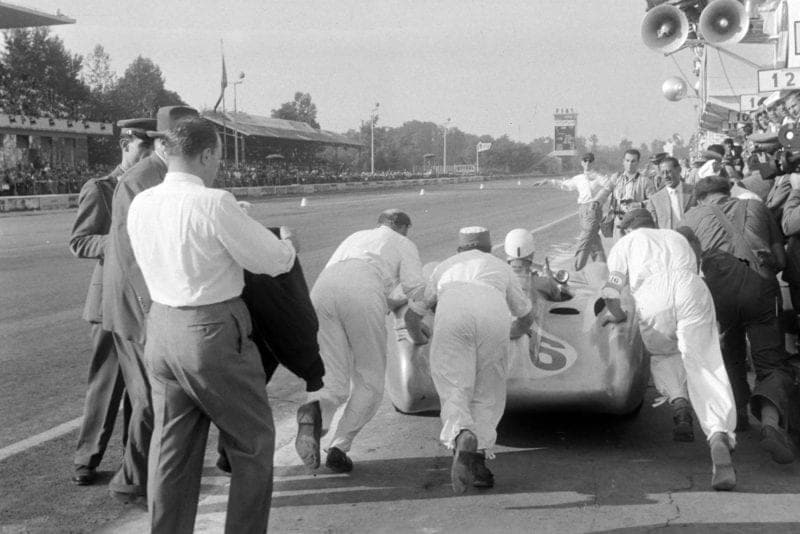
Moss is pushed out of the pits
Motorsport Images
Everything seemed set for another German demonstration, as at Aintree, but on the half-lap of lap 19 Moss suddenly drew into his pit with a shattered windscreen, it not being possible to stand a 170mph wind-pressure on his face. In a mere 1 min 40 sec the German mechanics removed the broken screen and frame and fitted a complete new one, the forethought of having a spare screen in the pits being so typical. This dropped Moss to eighth place, which indicated that everyone was trying hard, but now, with a clear run in front of him Moss was able to have a-real go and soon set up a new lap record and galloped past Gould, closing on Hawthorn very rapidly. Meanwhile the race between Castellotti and Musso was going on unabated, they passing and repassing continuously.
By lap 25, which was half-distance, Musso had won his battle and Moss was closing on Behra, while Mieres was making up for his pit stop and gaining ground. Collins retired, as did Silva Ramos, and Gould stopped to change a back tyre, while the first three positions were still Fangio, Kling and Taruffi in that order. The next one to drop out of this gruelling race was Pollet, and shortly after starting his 28th lap Moss felt something break in the Mercedes-Benz engine, and he coasted to a standstill on the far side of the circuit, so that put paid to all his efforts, the Monza track once more claiming the unhappy young Englishman as a victim.
“The Mercedes-Benz demonstration was now looking rather sick and at the end of lap 32 it became positively ill”
The Mercedes-Benz demonstration was now looking rather sick and at the end of lap 32 it became positively ill when Kling came to rest with a broken gearbox. However, Fangio and Taruffi were holding the fort and providing no more mechanical bits broke due to the hammering of the track, a German victory seemed certain, especially as Musso had broken his car and only Castellotti and Behra remained on the same lap as the leaders.
Gould also went out when he rubbed a hole in the bottom of the crankcase of his Maserati, due to bottoming on the banking, and Fitch appeared on the leader board, running regularly with the Moss Maserati. Behra lapped Menditeguy, and the Argentine driver tucked in behind and refused to be shaken off, while a little later Hawthorn was lapped by Taruffi and did the same thing, getting a useful tow along the straights, though finding his Ferrari handling much better than the Mercedes-Benz on the bankings, and actually being able to overtake the Italian at times. These efforts were unrewarded as the gearbox of the Ferrari broke its mountings and after fighting against the terrific vibration for a time Hawthorn eventually gave up on the 39th lap.
At this point the engine of Mieres’ Maserati went very rough but managed to keep going, though he lost a place to Menditeguy, who was profiting by his tow from Behra with the streamlined Maserati. For the last 10 laps there were only nine cars left running, Fangio, Taruffi, Castellotti and Behra being on the same lap, with Menditeguy, Maglioli, Mieres, Trintignant and Fitch varying distances behind. Mercedes-Benz had two cars left out of four, Maserati four cars out of seven and Ferrari three out of four, Castellotti’s car sounding very healthy in spite of having been taken to 8,200 rpm in the opening dice.
Due to the arrangement of the track the cars passing on the outside of the finishing straight were very highly wound-up in top, having come off the south banking, while those on the inside were still accelerating out of the flat south corner. The result was the odd sight of a comparatively slow Ferrari or Maserati on the outside rushing past Fangio and Taruffi, who were on the slow inside straight, this phenomenon giving many drivers their only chance to experience the joy of overtaking a Mercedes-Benz.
Round and round went Fangio, very tired and bruised from the hard strain imposed by the new circuit, for apart from the bumps on the bankings the average speed wan well over 200 kph (125 mph), and be once more proved his claim to World Champion; Taruffi was a worthy second, having driven a splendid race for one who is no longer a young man. Hero of the day was undoubtedly Castellotti, who had proved himself Italy’s real hope, while Behra was following him in fourth place in the pretty streamlined Maserati.
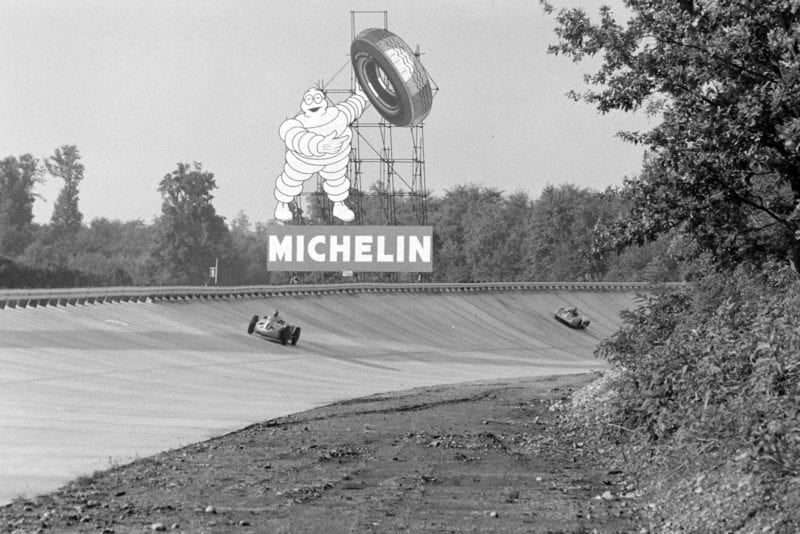
Kling chases Fangio
Motorsport Images
As the Frenchman started on his 50th lap the Maserati engine made a ghastly noise and smoke poured out. When he came by the pits on the half lap the car could hardly drag itself along, the noise and smoke being horrible to witness, but the determined Behra nursed it along and just managed to limp over the finishing line, to stop a few yards beyond in a cloud of smoke and oil, the engine a total wreck.
“The W196 Mercedes-Benz cars raced their last race and unless Daimler-Benz change their mind the Italian Grand Prix saw the last appearance of these formidable Grand Prix cars”
The W196 Mercedes-Benz cars raced their last race and unless Daimler-Benz change their mind, or further alterations are made to the Calendar before the end of the season, the Italian Grand Prix saw the last appearance of these formidable Grand Prix cars. It is worth recording that from their first appearance in July, 1954, to their last appearance in September, 1955, they won 10 races, were only beaten three times, and failed to finish any cars at all on one occasion, and that was the only time Fangio did not finish a Grand Prix all the time he has led the team.
Though the Lancias did not start in the race, they proved in practice to be the most serious opponents to the German cars and it is nice to know that these very fine Italian cars are going to continue to race. The new Gordini was still a bit too new and never really showed any form, while the Vanwall showed that it still has possibilities when driven by an enthusiastic driver like Schell. That Grand Prix racing is still the most popular and certainly the safest form of racing, was evidenced by the enormous crowds that flocked to Monza and the complete lack of incidents in this very high-speed race.
* * *
1955 Italian Grand Prix race results
1. Juan Manuel Fangio (Mercedes) 2:25:04.4
2. Piero Taruffi (Mercedes) + 0.7
3. Eugenio Castellotti (Ferrari) + 46.2
4. Jean Behra (Maserati) + 3:57.5
5. Carlos Menditeguy (Maserati) + 1 lap
6. Umberto Maglioli (Ferrari) + 1 lap
7. Roberto Mieres (Maserati) + 2 laps
8. Maurice Trintignant (Ferrari) + 3 laps
9. John Fitch (Maserati) + 4 laps
10. Mike Hawthorn (Ferrari) Retired – Gearbox
11. Karl Kling (Mercedes) Retired – Gearbox
12. Luigi Musso (Maserati) Retired – Gearbox
13. Horace Gould (Maserati) Retired – Suspension
14. Stirling Moss (Mercedes) Retired – Engine
15. Jacques Pollet (Gordini) Retired – Engine
16. Hermano da Silva Ramos (Gordini) Retired – Fuel System
17. Peter Collins (Maserati) Retired – Suspension
18. Harry Schell (Vanwall) Retired – Suspension
19. Jean Lucas (Gordini) Retired – Engine
20. Ken Wharton (Vanwall) Retired – Injection
21. Guiseppe Farina (Ferrari) Did not start
22. Luigi Villoresi (Ferrari) Did not start
23. Luigi Piotti (Maserati) Did not start
Championship Standings
1. Juan Manuel Fangio – 40 (41)
2. Stirling Moss – 23
3. Eugenio Castellotti – 12
4. Maurice Trintignant – 11 1/3
5. Guiseppe Farina – 10 1/3
